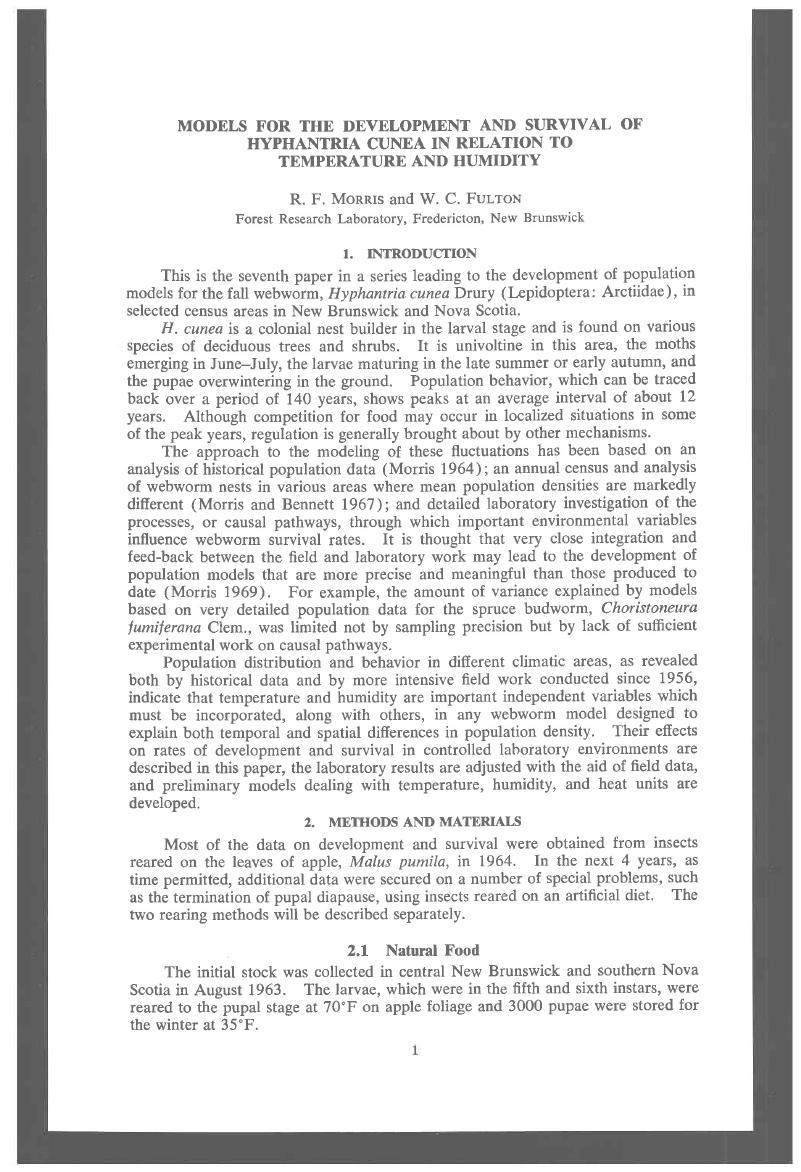Crossref Citations
This article has been cited by the following publications. This list is generated based on data provided by Crossref.
Morris, R. F.
and
Fulton, W. C.
1970.
HERITABILITY OF DIAPAUSE INTENSITY IN HYPHANTRIA CUNEA AND CORRELATED FITNESS RESPONSES.
The Canadian Entomologist,
Vol. 102,
Issue. 8,
p.
927.
Morris, R. F.
1971.
THE INFLUENCE OF LAND USE AND VEGETATION ON THE POPULATION DENSITY OF HYPHANTRIA CUNEA.
The Canadian Entomologist,
Vol. 103,
Issue. 11,
p.
1525.
Morris, R. F.
1971.
OBSERVED AND SIMULATED CHANGES IN GENETIC QUALITY IN NATURAL POPULATIONS OF HYPHANTRIA CUNEA.
The Canadian Entomologist,
Vol. 103,
Issue. 6,
p.
893.
Syme, Paul D.
1972.
THE INFLUENCE OF CONSTANT TEMPERATURES ON THE NON-DIAPAUSE DEVELOPMENT OF HYSSOPUS THYMUS (HYMENOPTERA: EULOPHIDAE).
The Canadian Entomologist,
Vol. 104,
Issue. 1,
p.
113.
Cheng, H. H.
1972.
OVIPOSITION AND LONGEVITY OF THE DARK-SIDED CUTWORM, EUXOA MESSORIA (LEPIDOPTERA: NOCTUIDAE), IN THE LABORATORY.
The Canadian Entomologist,
Vol. 104,
Issue. 6,
p.
919.
Morris, R. F.
1972.
FECUNDITY AND COLONY SIZE IN NATURAL POPULATIONS OF HYPHANTRIA CUNEA.
The Canadian Entomologist,
Vol. 104,
Issue. 3,
p.
399.
Morris, R. F.
1972.
PREDATION BY WASPS, BIRDS, AND MAMMALS ON HYPHANTRIA CUNEA.
The Canadian Entomologist,
Vol. 104,
Issue. 10,
p.
1581.
Bracken, G. K.
and
Dondale, C. D.
1972.
FERTILITY AND SURVIVAL OF ACHAEARANEA TEPIDARIORUM (ARANEIDA: THERIDIIDAE) ON A DIET OF CHEMOSTERILIZED MOSQUITOES.
The Canadian Entomologist,
Vol. 104,
Issue. 11,
p.
1709.
Wellington, W. G.
Cameron, P. J.
Thompson, W. A.
Vertinsky, I. B.
and
Landsberg, A. S.
1975.
A stochastic model for assessing the effects of external and internal heterogeneity on an insect population.
Population Ecology,
Vol. 17,
Issue. 1,
p.
1.
JAENIKE, JOHN
and
SELANDER, ROBERT K.
1980.
ON THE QUESTION OF HOST RACES IN THE FALL WEBWORM, HYPHANTRIA CUNEA.
Entomologia Experimentalis et Applicata,
Vol. 27,
Issue. 1,
p.
31.
Bisabri-Ershadi, B.
and
Ehler, L. E.
1981.
Natural biological control of western yellow-striped armyworm,Spodoptera praefica(Grote), in hay alfalfa in northern California.
Hilgardia,
Vol. 49,
Issue. 5,
p.
1.
Stark, Steven B.
and
Aliniazee, M. T.
1982.
Evaluation of modifications to a basic thermal summation model for predicting the time of emergence of the adult western cherry fruit fly, Rhagoletis indifferens Curran (Dipt., Tephritidae)1.
Zeitschrift für Angewandte Entomologie,
Vol. 94,
Issue. 1-5,
p.
401.
Williams, Kathy S.
and
Myers, Judith H.
1984.
Previous herbivore attack of red alder may improve food quality for fall webworm larvae.
Oecologia,
Vol. 63,
Issue. 2,
p.
166.
HAGEN, ROBERT H.
and
LEDERHOUSE, ROBERT C.
1985.
Poly modal emergence of the tiger swallowtail, Papilio glaucus (Lepidoptera: Papilionidae): source of a false second generation in central New York State.
Ecological Entomology,
Vol. 10,
Issue. 1,
p.
19.
Grossmueller, David W.
and
Lederhouse, Robert C.
1985.
Oviposition site selection: an aid to rapid growth and development in the tiger swallowtail butterfly, Papilio glaucus.
Oecologia,
Vol. 66,
Issue. 1,
p.
68.
BARBOSA, PEDRO
and
BALTENSWEILER, WERNER
1987.
Insect Outbreaks.
p.
469.
Mattson, William J.
and
Haack, Robert A.
1987.
The Role of Drought in Outbreaks of Plant-Eating Insects.
BioScience,
Vol. 37,
Issue. 2,
p.
110.
Ahmad, T. R.
1988.
Degree‐days requirements for predicting emergence and flight of the codling moth Cydia pomonella (L.) (Lep., Olethreutidae).
Journal of Applied Entomology,
Vol. 106,
Issue. 1-5,
p.
345.
GOMI, Tadashi
and
TAKEDA, Makio
1990.
The Transition to a Trivoltine Life Cycle and Mechanisms That Enforce the Voltinism Change in Hyphantria cunea DRURY (Lepidoptera : Arctiidae) in Kobe.
Applied Entomology and Zoology,
Vol. 25,
Issue. 4,
p.
483.
Nilssen, Arne
and
Tenow, Olle
1990.
Diapause, embryo growth and supercooling capacity of Epirrita autumnata eggs from northern Fennoscandia.
Entomologia Experimentalis et Applicata,
Vol. 57,
Issue. 1,
p.
39.





